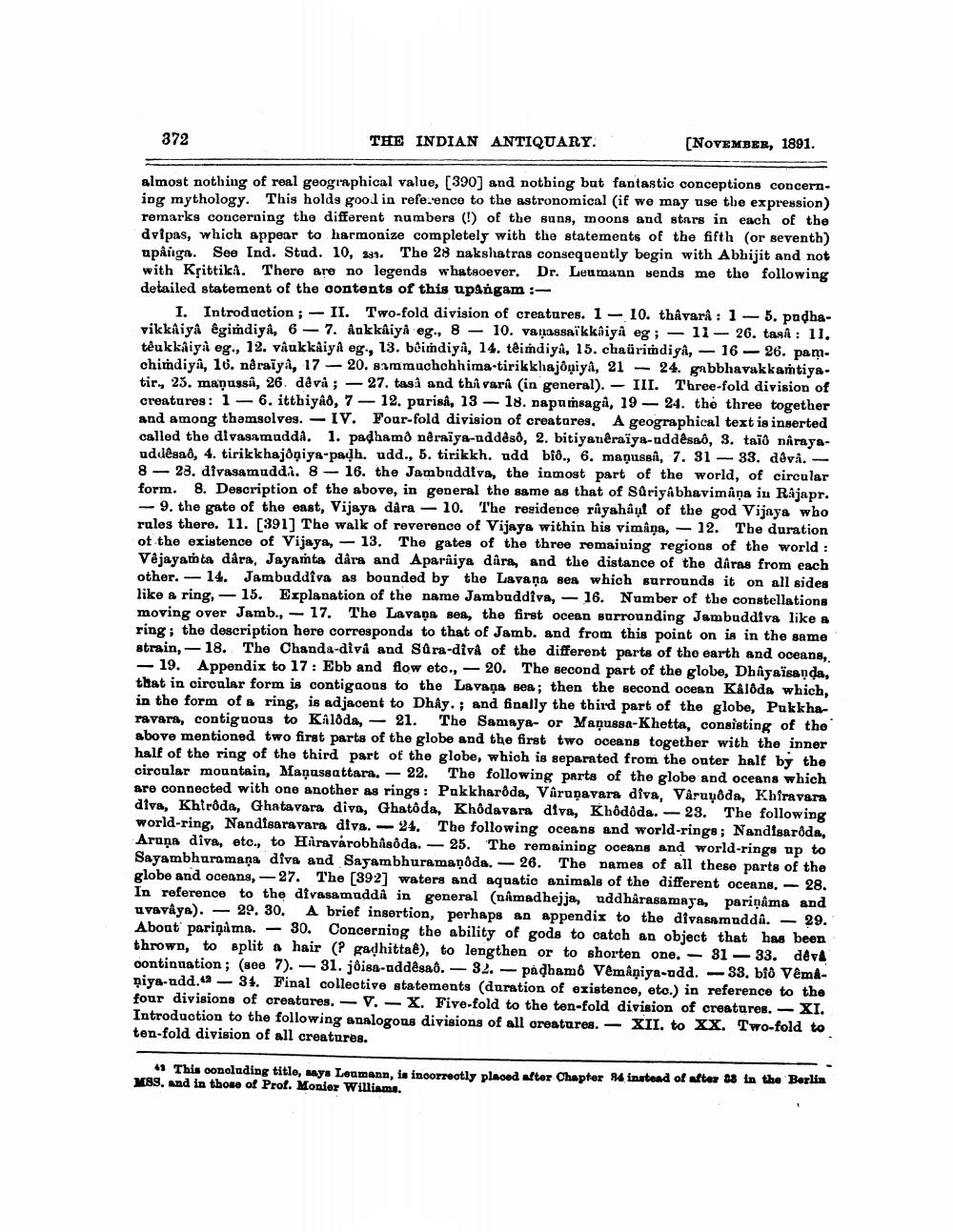________________
372
THE INDIAN ANTIQUARY.
(NOVEMBER, 1891.
almost nothing of real geographical value, [390] and nothing but fantastic conceptions concern. ing mythology. This holds good in reference to the astronomical (if we may use the expression) remarks concerning the different numbers (!) of the suns, moons and stars in each of the dvipas, which appear to harmonize completely with the statements of the fifth (or seventh) apäiga. See Ind. Stud. 10, 835. The 28 nakshatras consequently begin with Abhijit and not with Krittika. There are no legends whatsoever. Dr. Leumann sends me the following detailed statement of the contents of this upangam :
1. Introduction : - II. Two-fold division of crentures. 1-10. thivara : 1-5. padhavikkaiyâ êgimdiya, 6 - 7. Aakkiya eg., 8 - 10. vaassaïkkaiya eg; -11 - 26. tasi : 11. têukkaiya eg., 12. vậukkaiya eg., 13. bởimdiya, 14. têimdiya, 15. chaürindiga, - 16 - 26. pam. chimdiya, 16. nô raïya, 17 - 20. sammuchchhima-tirik khajôniya, 21 - 24. gabbhavakkantiyatir, 23. maņussa, 26. dévà ; - 27. tasi and thi varů (in general). – III. Three-fold division of creatures: 1 - 6. itthiyâð, 7 - 12. purisa, 13-18. napamsaga, 19 - 24. the three together and among thamsolves. - IV. Four-fold division of creatures. A geographical text is inserted called the divasamadda. 1. padhamð nêraiya-uddésô, 2. bitiyanêraïya-uddesaô, 3. taīð nárayauddêsaô, 4. tirikkhajôņiya-padh, udd., 5. tirikkh. add bid., 6. maņussi, 7. 31 - 33. dévå. 8 - 23. divasamuddl. 8 - 16. the Jambnddiva, the inmost part of the world, of circular form. 8. Description of the above, in general the same as that of SûriyAbhavimâna in Rajapr.
- 9. the gate of the east, Vijaya dara-10. The residence rûyahâțl of the god Vijaya who rules there. 11. [391] The walk of reverence of Vijaya within his vimiņa, - 12. The duration of the existence of Vijaya, - 13. The gates of the three remaining regions of the world : Vêjayam ta dara, Jayanta dåra and Aparâiya dara, and the distance of the daras from each other. - 14. Jambuddiva as bounded by the Lavaņa bes which surrounds it on all sides like a ring, - 15. Explanation of the name Jambuddiva, - 16. Number of the constellations moving over Jamb., - 17. The Lavana sea, the first ocean surrounding Jambuddiva like a ring; the description here corresponds to that of Jamb. and from this point on is in the same strain, - 18. The Chanda-divå and Sara-divå of the different parts of the earth and oceans,
- 19. Appendix to 17: Ebb and flow eto., - 20. The second part of the globe, Dhîyažbanda, that in circular form is contigaons to the Lavana ses; then the second ocean Kaloda which, in the form of a ring, is adjacent to Dhây.; and finally the third part of the globe, Pakkharavara, contiguous to Kiloda, -21. The Samaya- or Maņussa-Khetta, consisting of the above mentioned two first parts of the globe and the first two oceans together with the inner half of the ring of the third part of the globe, which is separated from the outer half by the circular mountain, Maņasgattara. - 22. The following parts of the globe and oceans which are connected with one another as rings: Pakkharðda, Vârunavara diva, Våruyðda, Khiravara diva, Khirðda, Ghatavara diva, Ghatoda, Khôdavara diva, Khôdôda. - 23. The following world-ring, Nandisara vara diva. - 24. The following oceans and world-rings; Nandisarôda, Aruņa diva, etc., to Hiravárobhísôda. - 25. The remaining oceans and world-rings up to Sayambhuramaņa diva and Sayambhuramaņôda. - 26. The names of all these parts of the globe and oceans, -27. The (392] waters and aquatio animals of the different oceans. - 28. In reference to the divasamudda in general (nâmadhejja, uddhårasamaya, pariņams and uvavậya). – 29. 30. A brief insertion, perhaps an appendix to the divasamuddll. - 29. About pariņima. - 30. Concerning the ability of gods to catch an object that has been thrown, to split hair (P gadhittaê), to lengthen or to shorten one. - 81 - 33. deva continuation ; (see 7). - 31. jðisa-uddêsaô. — 32. - padham Vêmâniya-udd. - 33. bið Vêmeniya-udd. - 31. Final collective statements (duration of existence, etc.) in reference to the four divisions of creatures. - V. -X. Five-fold to the ten-fold division of creatures. - XI. Introduction to the following analogous divisions of all oreatures. - XII. to xx. Two-fold to ton-fold division of all creatures.
41 This oonoluding titlo, says Leumann, is incorrectly placed after Chapter 84 instead of after 88 in the Berlin 89, and in those of Prof. Monier Williams.




